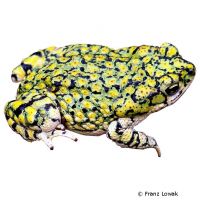Green Toad (Anaxyrus debilis)
| Green Toad Anaxyrus debilis | |
|---|---|
| Name | Green Toad |
| Name Lat. | Anaxyrus debilis |
| Synonym | Bufo debilis |
| Family | Bufonids |
| Family lat. | Bufonidae |
| Order | Frogs & Toads |
| Order lat. | Anura |
| Origin | USA |
| Habitat | Grassland |
| Diet | Small live insects |
| Humidity | 60-70 % |
| Behavior | Peaceful, nocturnal |
| Keeping | Pair, group |
| Care Level | Moderate |
| Breeding | Moderately difficult |
| Housing | Semi-humid terrarium |
| Life Span | 10 years |
| Protection | No |
| Metric Units | |
| Size | 3-5 cm |
| Temperature | 24-26 °C |
| Housing Size | 40 x 30 x 45 cm |
| US Units | |
| Size | 1.2"-2" |
| Temperature | 75-79 °F |
| Housing Size | 15" x 10" x 20" |
Distribution and habitat
The range of the crepuscular to nocturnal Green Toad is in the southwestern United States, extending from Kansas through Texas and Arizona to southeastern Colorado and northern Mexico, where it prefers to live in the semi-arid steppes, near small bodies of water.
Maintenance
For 1 animal, the minimum terrarium area is 1,200 cm², with a minimum effective height (measured without substrate) of 35 cm. This corresponds to a base area of e.g. 40 x 30 cm, for 2 animals at least 40 x 50 cm. The terrarium should be placed in a quiet place without sunlight.
You need a terrarium with a substrate of loose, absorbent, non-rotting substrate such as. Sand-peat mixture, coconut fibers or Sphagnum moss with a drainage and a shallow watering place as large as possible, in addition branched climbing branches, preferably entwined by climbing plants, with horizontal perches, back and side wall coverings made of e.g. natural cork boards and a dense planting (e.g. Tradescantia, Ficus, Scindapsus, ferns). Potted plants that can be easily removed for cleaning are advantageous. At least once a day the inside of the terrarium must be finely sprayed with water (humidity), but a rain or mist system is better.
| Temp. day: 24-26 °C | Temp. night: 20-22 °C | Humidity: 60-70 |
The lighting duration must be 10-14 hrs. depending on the season. Daylight fluorescent tubes with low UV content are ideal.
Diet
According to their size, the food offer consists of live springtails, enchyträen, Drosophila, ants, spiders, microheimchen, small grasshoppers and crickets or a commercial ready-made food for insectivores, which is usually well accepted after habituation. Food should be offered to adult animals 2-3 times a week, young animals must be fed daily. It is important to add minerals and vitamins regularly (e.g. by dusting the feed animals). The quality of the feed animals can be enhanced by feeding overripe fruit and honey water
A varied diet promotes health and prevents deficiency symptoms.
Reproduction and breeding
Both sexes are similarly colored. Females grow slightly larger than males.
After winter dormancy and with sufficient moisture, the female, ready to spawn, is taken in the mating grip (amplexus) by the male, which attracts attention by loud calling, and it lays up to 1200 eggs in strings usually at the bottom of temporary pools or slow-flowing streams. After 2-3 days, the tadpoles hatch and often form groups to be better protected from predators. They feed mainly on algae and detritus. After about 3-4 weeks the transformation (metamorphosis) is completed and the toad leaves the water
The life span can be over 10 years.
Important
The warts above the eyes can release a toxic secretion that serves as a deterrent to predators and parasites.
Before purchasing, a terrarium should be prepared that meets the species-specific needs. Good ventilation without drafts is necessary, as well as equipment for measuring temperature and humidity. The lighting has to correspond to the species-specific day-night rhythm and should be placed in such a way that the animals cannot injure themselves. The terrarium should be locked in such a way that neither unauthorized persons can open it nor the animals can escape. Special attention must be paid to thorough hygiene and impurities must be removed regularly
Further literature can be found in your pet store
References
Text: Serena Werle; Image: Franz Lowak
Source: VDA & DGHT (2006): Haltungsrichtlinien für die Haltung von Anuren; ENGELMANN (2006): Zootierhaltung - Tiere in menschlicher Obhut: Reptilien und Amphibien, Harri Deutsch Verlag
- Gemäß § 21 Abs. 5 Tierschutzgesetz idgF
